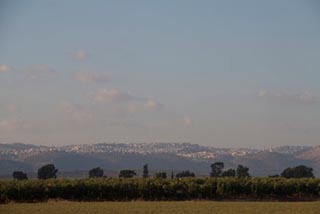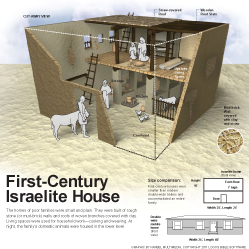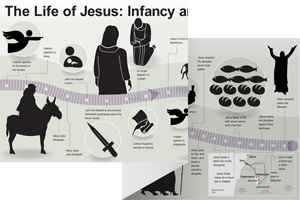2:1–7 After narrating John’s birth, Luke relates the birth of Jesus. In this section, he explains how Jesus came to be born in Bethlehem. |
2:1 Caesar Augustus Ruler of the Roman Empire.
 Political Leaders in the New Testament Table
Political Leaders in the New Testament Table
Born Gaius Octavius in September of 63 bc, the Roman senate gave him the name “Augustus” in 27 bc to honor his defeat and annexation of Egypt. Formerly one of three co-rulers, Augustus gained sole control of the empire and reigned from 27 bc to ad 14. Although harsh and unrelenting, he was a master administrator who restored order to the empire after two decades of civil war. He was responsible for ushering in Rome’s Golden Age—an era known as Pax Romana or Pax Augusta (meaning “Roman Peace” or “Augustus’ Peace”), which lasted for roughly 250 years. |
Roman Emperors in Luke | |
Caesar Augustus | 27 bc–ad 14 |
Tiberius | ad 14–37 |
to register all the empire Known censuses in proximity to Caesar Augustus’ reign (27 bc–ad 14) occurred around 28 bc, 8 bc, and ad 14. Given the size of the Roman Empire, the task of registering its people would have taken years; consequently, Luke could be pointing to the census of 8 bc. Based on the reference to Quirinius (see v. 2 and note), this would place Jesus’ birth around 6–4 bc.
2:2 Quirinius was governor of Syria Quirinius was a legate or emissary of Augustus Caesar. He served in this capacity ad 6–9, and conducted a census in about ad 6 (see Acts 5:37). However, he may have served on two separate occasions. A possible term in 6–4 bc would align with a potential date for Jesus’ birth (compare Luke 2:1 and note).
2:3 to his own town See note on v. 4.
2:4 Nazareth See 1:26 and note.
to the city of David Joseph must travel to his ancestral city for the census. Since he is a descendant of King David (1:27; 3:31), he travels to David’s hometown of Bethlehem (1 Sam 16:1, 4; 17:12; compare Matt 2:5–6).
2:6 while they were there In Bethlehem.
2:7 her firstborn son Luke probably notes this detail here because Yahweh had consecrated Israel’s firstborn children (Num 3:13).
wrapped him in strips of cloth Wrapping or swaddling provides warmth, comfort, and security to newborn infants (and is still practiced today).
a manger A trough out of which animals were fed. This may imply that they were in a barn of some sort, but a house is a stronger possibility; animals were often kept indoors at night in the house’s lower level.
the inn The Greek text here (at the end of this verse) uses the term katalyma in reference to a guest room (compare Luke 22:11).
2:8–21 In this passage, angels announce the news of Jesus’ birth to shepherds. |
2:8 shepherds By noting that the announcement comes to lowly shepherds rather than to the religious elite, Luke continues the theme developed in 1:48–52 (compare 7:22).
2:10 do not be afraid See note on 1:13.
good news The Greek word used here, euangelion, commonly refers in Luke’s Gospel to the saving message that the savior of humanity has come into the world.
 Euangelion Word Study
Euangelion Word Study
which will be for all the people Hints that the good news is not just for Jewish people, but also for non-Jewish people.
2:11 a Savior In Mary’s song of praise, this title refers to Yahweh (1:47); now it is aptly applied to Jesus.
Christ the Lord The angels employ two titles: “Christ” or “Messiah” emphasizes Jesus’ anointing as God’s promised Servant; “Lord” emphasizes His sovereign authority.
city of David Refers to Bethlehem (see v. 4 and note).
2:12 lying in a manger Mangers—though quite familiar to the shepherds—were unusual beds for babies (v. 7). This oddity would serve as a sign to the shepherds that they had found the Messiah.
2:13 a multitude of the heavenly army Refers to a massive group of angels.
 Angels in the Bible Table
Angels in the Bible Table
2:14 Glory to God This third hymn in Luke’s birth narratives echoes the angelic song in Isa 6:3 (see Luke 1:27 and note; compare 1:46–55, 68–79).
in the highest A reference to God’s abode (compare 19:38).
on earth The angels’ reference to glory in the highest heaven is complemented by their message of peace of earth.
peace The Greek word used here, eirēnē, is similar in meaning to the Hebrew word shalom (which means “peace,” “wholeness,” or “completeness”); it carries connotations of well-being, harmony, and security. Peace is a major theme of Luke’s Gospel (e.g., 1:79; 7:50; 10:5–6; 19:38; 24:36).
 Political Leaders in the New Testament Table
Political Leaders in the New Testament Table
2:16 lying in the manger Fulfills Luke 2:12.
2:19 pondering them in her heart See 1:66; 2:51.
2:21 when eight days were completed See 1:59 and note.
name that he was called by the angel See 1:31 and note.
2:22–24 In obedience to the law, Joseph and Mary offer a sacrifice to God in the temple. |
2:22 the days of their purification According to the law, Mary had to undergo a time of purification after giving birth (see Lev 12:1–4).
2:23 will be called holy to the Lord In a separate ceremony from Mary’s purification, Jesus is consecrated. See Exod 13:2, 12; Num 3:13.
2:24 pair of turtledoves or two young pigeons The offering of a poor woman. The law stipulated that a lamb be offered, but if the woman could not afford a lamb then she could offer two turtledoves or pigeons (Lev 12:8).
2:25–35 While they are at the temple, Joseph and his family are introduced to two prophetic figures. The first is Simeon—an elderly prophet to whom God made a promise (see Luke 2:26). Simeon longed to see the arrival of the Messiah; when he finally meets Him, he delivers a message of hope and sorrow to Mary and Joseph. |
2:25 the consolation of Israel This likely alludes to ot prophecies anticipating a time of redemption for Israel, which would be signified by an incredible sense of Yahweh’s presence (e.g., Isa 40:1–2, 10–11; 61:1–2; compare Luke 2:38). This time of restoration was expected to be accomplished through Yahweh’s anointed representative, the Messiah (christos in Greek).
Holy Spirit was upon him A common theme in Luke’s Gospel (see Luke 1:15, 35, 41, 67).
2:26 the Lord’s Christ This phrase refers to Yahweh’s anointed one.
2:29–32 This passage comprises the fourth hymn in Luke’s birth narratives. It is known as the Nunc dimittis because of how the first few words are translated in the Latin Vulgate (the Latin translation of the Bible). |
2:29 dismiss your slave in peace Simeon declares that he can die now that he has seen Yahweh’s Messiah (see v. 26).
2:30 your salvation See 1:27 and note; 1:47, 69; 2:11 (compare Isa 12:2–3).
2:32 revelation to the Gentiles These references—coupled with the whole-world decree in Luke 2:1—speak to the worldwide significance of Jesus’ arrival (compare v. 10 and note; v. 31). This line echoes Isa 42:6, which explains the vocation of Yahweh’s Suffering Servant.
2:34 fall and rise In words taken from Isa 8:14, Simeon summarizes the divided response people will later have to Jesus’ ministry (compare note on Luke 2:14).
2:35 sword will pierce your own soul also Perhaps a reference to the grief that Jesus’ premature death will bring Mary.
2:36–40 The second prophetic figure who encounters Jesus in the temple is the aged prophetess Anna. Upon seeing the child, she begins to praise God. |
2:36 prophetess Female prophets appear in Acts, as well (e.g., Acts 21:9), but they were rare in Israel’s history. Anna’s inclusion in Luke’s narrative continues the theme that Jesus is the savior of all people (Luke 2:10): Jesus’ identity was revealed to a man (Simeon) and now a woman.
Anna The Greek version of the Hebrew name Hannah—another reference to 1 Sam 1–2 (compare Luke 1:46–56 and note).
2:38 speak about him Refers to Jesus. Anna’s message likely echoes Simeon’s (vv. 30–32).
for the redemption of Jerusalem See v. 25 and note.
2:39 everything according to the law of the Lord See vv. 22–24.
2:40 the child was growing and becoming strong Compare 1:80; 2:52.
2:41–52 This story, which is unique to Luke’s Gospel, shifts from the birth narratives to Jesus’ early adolescence. It shows that Jesus was devout and understood His role from even the age of 12 When Jesus next appears in Luke’s narrative, He is about 30 and beginning His public ministry (3:23). |
2:41 to Jerusalem for the feast of the Passover Refers to the time that many Jewish people made pilgrimage to Jerusalem for the Jews’ annual commemoration of the exodus—God’s deliverance of their ancestors from bondage in Egypt (Exod 12–13; Deut 16:1–8). Passover is considered the most important feast of the Jewish calendar.
is considered the most important feast of the Jewish calendar.
2:44 group of travelers They were probably part of a caravan traveling from Nazareth to Jerusalem.
2:46 asking them questions Later, it is the teachers who question Jesus (e.g., 6:2; 10:25; 20:2, 22, 33).
2:47 were amazed Elsewhere, Luke uses the Greek verb here to indicate amazement at supernatural events, such as the reaction to Jesus raising a girl from the dead (8:56), the disciples speaking in tongues (Acts 2:7, 12), Saul’s conversion (Acts 9:21), and the Holy Spirit coming upon Gentiles (Acts 10:45).
2:49 in the house of my Father In the previous verse, Mary mentions Joseph, Jesus’ earthly father; in contrast, Jesus refers here to His heavenly Father.
2:51 his mother treasured all these things Compare Luke 1:66; 2:19.

|
About Faithlife Study BibleFaithlife Study Bible (FSB) is your guide to the ancient world of the Old and New Testaments, with study notes and articles that draw from a wide range of academic research. FSB helps you learn how to think about interpretation methods and issues so that you can gain a deeper understanding of the text. |
| Copyright |
Copyright 2012 Logos Bible Software. |
| Support Info | fsb |
 Loading…
Loading…

 Augustus
Augustus 

